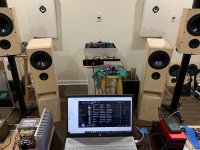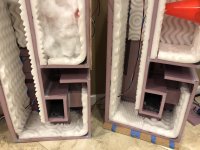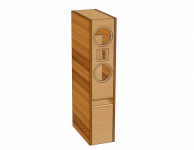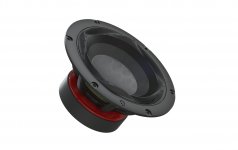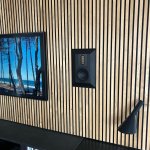Wow! Distortion is about 55 dB down from 100 Hz, maybe more. Was the mic calibrated for absolute SPL? how far was it from the speaker? or what was the drive level?
- 55 dB is about 0.05% distortion. It's curious that it should be like this across the band. Maybe you can turn up the level so we can actually see the components?
-55dB is 0,17% distortion
-> 10^(-55/20)= 0,001778279 ->0,17 %
I would be VERY interested in this floorstanding TL!
Joseph Crowe also has a floor standing purifi TL design.
Speaker No. 1198 --- Floorstanding Transmission Line – Joseph Crowe
I contacted him a few weeks back and he offered to sell the plans for a small fee, if you want to DIY which I’m seriously considering.
That Joseph Crowe is nice! I would buy the kit without the drivers, if I could get it down here!
I'm now brainstorming a TL design with the PTT6.5 + augerpro 6.5" waveguided SB26ADC which I have both of, and Jean Claude's Active/Standmount preliminary results look very good - also XRK has a nice looking TL design already modeled see his Harsch XO PTT6.5 thread. I'm not 100% happy with the ported and PR builds I've attempted so far. Dont get me wrong I could live with them but my thirst for improvements is not quenched. While the purifi is an amazing woofer, it's been difficult to get dialed in as a few builders have noted. TL seems to be the best compromise?
I'm now brainstorming a TL design with the PTT6.5 + augerpro 6.5" waveguided SB26ADC which I have both of, and Jean Claude's Active/Standmount preliminary results look very good - also XRK has a nice looking TL design already modeled see his Harsch XO PTT6.5 thread. I'm not 100% happy with the ported and PR builds I've attempted so far. Dont get me wrong I could live with them but my thirst for improvements is not quenched. While the purifi is an amazing woofer, it's been difficult to get dialed in as a few builders have noted. TL seems to be the best compromise?
I guess it’s all about your preferences and design goals.
I’ve got it in 19L and the bass is great. The midrange/treble integration is only as good as my crossover work, which gets better with every iteration. I’m not impatient to learn and grow, as I already have a very good full time speaker, and I don’t have to rush to market, which I may be tempted to do if it was a commercial.
But my goals is to challenge myself- to make it half the size (10L) and give up on 10Hz of bass extension.
So I’m going to bring is the SB passive radiator with 50g added mass...
Lots of ways to skin cat...
I’ve got it in 19L and the bass is great. The midrange/treble integration is only as good as my crossover work, which gets better with every iteration. I’m not impatient to learn and grow, as I already have a very good full time speaker, and I don’t have to rush to market, which I may be tempted to do if it was a commercial.
But my goals is to challenge myself- to make it half the size (10L) and give up on 10Hz of bass extension.
So I’m going to bring is the SB passive radiator with 50g added mass...
Lots of ways to skin cat...
I'm now brainstorming a TL design with the PTT6.5 + augerpro 6.5" waveguided SB26ADC which I have both of said:I am preferring the idea of a sealed enclosure and adding either equalisation or additional subs. My experience with TLs is, yes loads of extension but at the cost of tightness that only sealed can deliver. Maybe I am wrong and better dialled in design can prove that, but I love the tight and fast response that sealed seems to deliver. I have tried the Purifi in a couple of ported configs and am part way through a sealed implementation and will be interested to see which works better. I think if one concedes to need a sub then sealed is an easier implementation. TLs are as imposing in the room as any large system to me so rather a less intrusive satellite system and multiple subs tucked away out of sight.
I used to think the same thing and used a sealed 24L box for my 10F/RS225-8 quasi-transient perfect 2-way for years. I then explored the PMC style tapered TL with Akabak modeling that accounted for variable damping placement. The addition of proper damping in the modeling allows one to optimize the bass extension AND the group delay. A sealed woofer has about 4ms of GD at 50Hz (important kick drum frequency). A lightly stuffed TL or simple 4th order bass reflex or passive radiator alignment has about 15ms of GD at 50Hz. This is the so called “sloppy bass” timing we all know well. But when a tapered TL is properly stuffed and damping foam is applied in the right areas, the GD of the TL approaches the GD of a sealed cabinet. This was explored in my PMC style inspired TL in this thread. From that result, I explored making a TL version of the 10F/RS225 speaker and the result was breathtaking. The tightness of the kick drum bass was still there and the bass extension was deepened. Now I don’t even use a separate subwoofer anymore as it reaches below 30Hz. The other advantage seems to be an openness and higher level of mid bass clarity afforded by letting the woofer breathe easily rather than deal with all that compression of a sealed alignment. I compared the sealed and the TL side by side. The TL still has the tight bass.My experience with TLs is, yes loads of extension but at the cost of tightness that only sealed can deliver.
Here is the sealed and TL version of the same speaker:
Here is an example of the wall lining and stuffing used to achieve the right balance of bass extension and lower GD:
Attachments
Last edited:
The group delay and accordingly the "tightness" of the bass is related to low frequency extension AND the alignment. So statements like CB having 'x' amount of group delay, BR 'y' amount (or 2 to 3 times as much) vs. TL having again relatively low/er g.d. are misleading.
You would have to design your BR to be similar as much as possible to your TL in order to get a meaningful comparison. If you get them as close as possible, with the same cut-off frequency AND little to no difference in alignment (or 'q'), THEN you'll see that there ain't any substantial advantage (or actually none) of a TL over a BR.
You would have to design your BR to be similar as much as possible to your TL in order to get a meaningful comparison. If you get them as close as possible, with the same cut-off frequency AND little to no difference in alignment (or 'q'), THEN you'll see that there ain't any substantial advantage (or actually none) of a TL over a BR.
THEN you'll see that there ain't any substantial advantage (or actually none) of a TL over a BR.
How about box size. Same performance smaller box (or better performance same size box) is a fairly important trade off for most of us.
To be honest, I don't consider myself an expert on bass enclosures. It's just that I have been told long ago - by quite knowledgable guys - that in the end what really matters is the outcome: the curve, the highpass (its characteristics). If this highpass is reasonably "the same", then the impulse response (--> group delay) will also be the same. It's physics, no way around it.
In the same vein I am inclined to believe that in practice there won't be any significant differences in box volume when you really aim for a specific curve/highpass (with passive means), regardless whether you achieve it as BR or TL. But I may be wrong here ...
(Needless to say that going passive (and without DSP), not every set of TSP will be suitable to achieve a specific alignment.)
In the same vein I am inclined to believe that in practice there won't be any significant differences in box volume when you really aim for a specific curve/highpass (with passive means), regardless whether you achieve it as BR or TL. But I may be wrong here ...
(Needless to say that going passive (and without DSP), not every set of TSP will be suitable to achieve a specific alignment.)
Kceenav,
Good points and true that if same bass reflex tuned alignment (cutoff freq, and Q) will result in same GD. But tapered PMC style TLs tend to have much more efficient bass output that is not choked by a smaller vent restriction typically seen in compact reflex boxes. You have to admit a TL and a BR sound different, my opinion is that the TL sounds better and less compressed.
I have had well-informed members in the sub woofer forum argue with me that a bass reflex sub made as large as a tapped horn using the same driver will have the same performance if the alignment of Fc and Q are the same. That’s simply not true as anyone who had heard a tapped horn sub knows. One is a Helmholz resonator and the other is an aeroacoustic waveguide. Same with reflex box and tapered TL. A mass loaded TL is closer to a BR box than an aero acoustic waveguide.
Good points and true that if same bass reflex tuned alignment (cutoff freq, and Q) will result in same GD. But tapered PMC style TLs tend to have much more efficient bass output that is not choked by a smaller vent restriction typically seen in compact reflex boxes. You have to admit a TL and a BR sound different, my opinion is that the TL sounds better and less compressed.
I have had well-informed members in the sub woofer forum argue with me that a bass reflex sub made as large as a tapped horn using the same driver will have the same performance if the alignment of Fc and Q are the same. That’s simply not true as anyone who had heard a tapped horn sub knows. One is a Helmholz resonator and the other is an aeroacoustic waveguide. Same with reflex box and tapered TL. A mass loaded TL is closer to a BR box than an aero acoustic waveguide.
Last edited:
Hi Guys,
I guess I have not been following this thread closely enough but it seems there are like 4 variants of the PTT6.5 woofer. There are the 4 and 8ohms, but there are the “X” vs the “W” varieties. So 4 in all and the TS parameters are different enough to matter in a TL.
Approx 6"-7" Woofers (Purifi): Madisound Speaker Components
Take for example, the design of a WTW double driver TL design I just recently developed. With the “W” variant, I was getting 86dB sensitivity and 36Hz F3, 28Hz F6. Simply putting the “X” variety into the simulation, I got 33Hz F3 and 24Hz F6. Still 86dB and the same nice flat bandwidth. That’s a big difference.
Here is the sim results die the frequency response:
I guess I have not been following this thread closely enough but it seems there are like 4 variants of the PTT6.5 woofer. There are the 4 and 8ohms, but there are the “X” vs the “W” varieties. So 4 in all and the TS parameters are different enough to matter in a TL.
Approx 6"-7" Woofers (Purifi): Madisound Speaker Components
Take for example, the design of a WTW double driver TL design I just recently developed. With the “W” variant, I was getting 86dB sensitivity and 36Hz F3, 28Hz F6. Simply putting the “X” variety into the simulation, I got 33Hz F3 and 24Hz F6. Still 86dB and the same nice flat bandwidth. That’s a big difference.
Here is the sim results die the frequency response:
Attachments
Check out this nice 3D model of the PTT6.5 by Haze Head:
Purifi PTT6.5 3D Models
Now I don’t have to leave empty holes in the baffle of my 3D models of the TLs. 🙂
Purifi PTT6.5 3D Models
Now I don’t have to leave empty holes in the baffle of my 3D models of the TLs. 🙂
Attachments
Thats a really nice model, and it looks like they might be making a subtle suggestion to try a textreme cone in there too
"Textreme hint"
Haha, you know your materials! Unfortunately it was just to to with me being lazy and slapping a quick texture on for contrast. I do have a couple of textreme samples laying around though.
Haha, you know your materials! Unfortunately it was just to to with me being lazy and slapping a quick texture on for contrast. I do have a couple of textreme samples laying around though.
Looks very cool! Quite compact. I wonder whether it is suffit mounted or just has limited volume...
Interesting build on the Facebook DIY loudspeaker group. Purifi 6.5 and Mundorf AMT25 but in-wall design for AV application.
This is my build for the living room / home theater room, i can post pictures, box drawings measurements etc - but its probaly best done in a new thread - let me know if you are interested.
/kim
Please I am very much interested in your Purifi build. I am sure many will be keen to know since its a new woofer and not many builds listed yet. Please share your experience and build details
regards
anand
regards
anand
Hi Kim,
I just built new speakers for myself, but still I am very interested to hear more about your build!
I just built new speakers for myself, but still I am very interested to hear more about your build!
Fi25v1 Design, Build, and Testing
The initial speaker design I authored using Purifi drivers is the stand mount monitor Fi16v1. Fi noting the use of Purifi drivers, the 16 denoting enclosure volume in liters, and v1 denoting version 1 acknowledging the likelihood of future revisions or redesigns. The Fi25v1 is an evolution of and builds on lessons learned from Fi16v1 so the following links are provided to details of that design.
Backstory adventures with Fi16v1
About Fi16v1:
Exploring Purifi Woofer Speaker Builds
Second listening comments Fi16v1:
Exploring Purifi Woofer Speaker Builds
Finding the limits of Fi16v1:
Exploring Purifi Woofer Speaker Builds
PTT6.5W04 and the evil twins PTT6.5PR want to explode your speaker box:
https://www.diyaudio.com/forums/multi-way/352063-exploring-purifi-woofer-speaker-builds-48.html#post6383932
This has turned into quite the detailed account so I will post it in sections.
Fi25v1 CAD simulations
Fi16v1 is a stand mounted monitor so the next logical step seemed to be exploring the floor standing option. Pleased with the proportions of Fi16v1 I explored the oft cited “replace the stand with more speaker box” option. Thus retaining the 8.5 inch width and 10.75 inch width and height extended to 37.5 inches yields an enclosure volume of approximately 25 liters. Yes, in American design we constantly mix imperial and metric units, in centimeters that’s 21.6 cm W x 27.3 D x 95.25 tall. With the 25L volume in mind woofer/box alignment simulations in WinISD explore how the PTT6.5W reacts to various enclosure volumes, something to look into before the sawdust starts to fly. The following graph shows five possibilities.
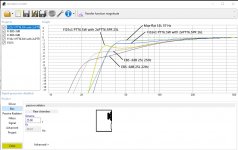
The green curve labeled ‘Max flat 15L 37 Hz’ is I believe essentially the Purifi SPK5 application note design (Tech. - PURIFI). As the label notes this is a 15L box tuned to 37 Hz via a port tube these numbers yielding the so called maximally flat alignment with response to –3dB at about 37 Hz.
Next the blue curve labeled ‘Fi16v1 PTT6.5W with 2xPTT6.5PR 16L’ shows added enclosure volume and lowering tuning Hz does not get more flat amplitude bass extension. The added liter of volume and lowering tuning from 37 Hz to 19 Hz lowers the 40 Hz to 80 Hz response by ~1 dB with only inconsequential change in the -3 dB point. Note in this and subsequent designs using PTT6.5PR passive radiators the 19 Hz tuning is the default of these PR’s thus becoming a given in the design. More typical of PRs in this size class is a default tuning in the 30s with option to lower with added weights. To date Purifi has been silent on why they chose 19 Hz as a default, these design experiences lead me to believe they know what they are doing. This 16L/19Hz alignment is a benchmark as I have many weeks enjoying this design in my system. An experience leading to the opinion the 1 dB drop in response CAD predicted when buried in room gain is overshowed by aspects like the PTT6.5W’s resetting of distortion standards. Now onto the larger enclosure volume alignments.
The two purple and grey curves labeled ‘EBS -3dB 25L 25Hz’ and ‘EBS -3dB 25L 22Hz’ are default alignments that can be selected in WinISD. These Extended Bass Shelf alignments look to reach deeper cutoffs using larger enclosure volumes and lower Hz port/PR tunings. For this low bass extension one trades off response flatness and power handling.
And finally the yellow curve ‘Fi25v1 PTT6.5W with 2xPTT6.5PR 23L’ illustrates what happens in CAD when the 16 liter box is increased to 23 liters. Not as much ‘shelf’ as the EBS alignments rather we see extra output in the 30 to 35 Hz band at the expense of another dB loss between 50 to 100 Hz. This curve certainly illustrates that when the drivers (and here passive radiators) T/S parameters remain fixed more enclosure volume over the max flat optimum yields questionable or shall we say interesting results.
An interesting question I set out to answer curious how those response changes would interact with room acoustics’ low frequency gain. And no doubt slanted by really wanting a slim Euro style floor stander with Purifi drive units. Detailed out the design looked like the drawing.
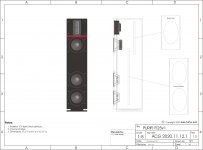
With its 25 liter enclosed volume this design was named F25v1. Like the stand mount Fi16v1 the woofer is a Purifi PTT6.5W-04, 2 each PT6.5W passive radiators and the tweeter a Fountek NeoCD2.0. The crossover is at line level based on Marchand Electronics PCBs with bi-amping power from ACG 1000 series amplifiers. Moving crossover to more conventional power level Ls and Cs awaits the basic design proving itself.
The initial speaker design I authored using Purifi drivers is the stand mount monitor Fi16v1. Fi noting the use of Purifi drivers, the 16 denoting enclosure volume in liters, and v1 denoting version 1 acknowledging the likelihood of future revisions or redesigns. The Fi25v1 is an evolution of and builds on lessons learned from Fi16v1 so the following links are provided to details of that design.
Backstory adventures with Fi16v1
About Fi16v1:
Exploring Purifi Woofer Speaker Builds
Second listening comments Fi16v1:
Exploring Purifi Woofer Speaker Builds
Finding the limits of Fi16v1:
Exploring Purifi Woofer Speaker Builds
PTT6.5W04 and the evil twins PTT6.5PR want to explode your speaker box:
https://www.diyaudio.com/forums/multi-way/352063-exploring-purifi-woofer-speaker-builds-48.html#post6383932
This has turned into quite the detailed account so I will post it in sections.
Fi25v1 CAD simulations
Fi16v1 is a stand mounted monitor so the next logical step seemed to be exploring the floor standing option. Pleased with the proportions of Fi16v1 I explored the oft cited “replace the stand with more speaker box” option. Thus retaining the 8.5 inch width and 10.75 inch width and height extended to 37.5 inches yields an enclosure volume of approximately 25 liters. Yes, in American design we constantly mix imperial and metric units, in centimeters that’s 21.6 cm W x 27.3 D x 95.25 tall. With the 25L volume in mind woofer/box alignment simulations in WinISD explore how the PTT6.5W reacts to various enclosure volumes, something to look into before the sawdust starts to fly. The following graph shows five possibilities.

The green curve labeled ‘Max flat 15L 37 Hz’ is I believe essentially the Purifi SPK5 application note design (Tech. - PURIFI). As the label notes this is a 15L box tuned to 37 Hz via a port tube these numbers yielding the so called maximally flat alignment with response to –3dB at about 37 Hz.
Next the blue curve labeled ‘Fi16v1 PTT6.5W with 2xPTT6.5PR 16L’ shows added enclosure volume and lowering tuning Hz does not get more flat amplitude bass extension. The added liter of volume and lowering tuning from 37 Hz to 19 Hz lowers the 40 Hz to 80 Hz response by ~1 dB with only inconsequential change in the -3 dB point. Note in this and subsequent designs using PTT6.5PR passive radiators the 19 Hz tuning is the default of these PR’s thus becoming a given in the design. More typical of PRs in this size class is a default tuning in the 30s with option to lower with added weights. To date Purifi has been silent on why they chose 19 Hz as a default, these design experiences lead me to believe they know what they are doing. This 16L/19Hz alignment is a benchmark as I have many weeks enjoying this design in my system. An experience leading to the opinion the 1 dB drop in response CAD predicted when buried in room gain is overshowed by aspects like the PTT6.5W’s resetting of distortion standards. Now onto the larger enclosure volume alignments.
The two purple and grey curves labeled ‘EBS -3dB 25L 25Hz’ and ‘EBS -3dB 25L 22Hz’ are default alignments that can be selected in WinISD. These Extended Bass Shelf alignments look to reach deeper cutoffs using larger enclosure volumes and lower Hz port/PR tunings. For this low bass extension one trades off response flatness and power handling.
And finally the yellow curve ‘Fi25v1 PTT6.5W with 2xPTT6.5PR 23L’ illustrates what happens in CAD when the 16 liter box is increased to 23 liters. Not as much ‘shelf’ as the EBS alignments rather we see extra output in the 30 to 35 Hz band at the expense of another dB loss between 50 to 100 Hz. This curve certainly illustrates that when the drivers (and here passive radiators) T/S parameters remain fixed more enclosure volume over the max flat optimum yields questionable or shall we say interesting results.
An interesting question I set out to answer curious how those response changes would interact with room acoustics’ low frequency gain. And no doubt slanted by really wanting a slim Euro style floor stander with Purifi drive units. Detailed out the design looked like the drawing.

With its 25 liter enclosed volume this design was named F25v1. Like the stand mount Fi16v1 the woofer is a Purifi PTT6.5W-04, 2 each PT6.5W passive radiators and the tweeter a Fountek NeoCD2.0. The crossover is at line level based on Marchand Electronics PCBs with bi-amping power from ACG 1000 series amplifiers. Moving crossover to more conventional power level Ls and Cs awaits the basic design proving itself.
- Home
- Loudspeakers
- Multi-Way
- Exploring Purifi Woofer Speaker Builds
